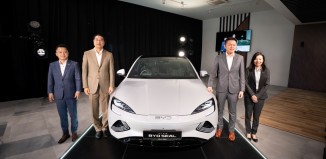The all-new Honda Accord
The wraps are off the next generation of the Honda Accord, with deliveries to commence in the US market this September. It is claimed to have undergone the most dramatic change in its 27-year history to bring ‘a new level of world-class style, performance and sophistication to the midsize class’.
The Accord, one of the best-selling cars in America, has entirely new styling for both sedan and coupe models. Styling for the sedan and coupe (which was specifically created for the US market) is more distinctive and aerodynamics have also been improved, from 0.33 Cd to 0.30 Cd for the sedan.
The stylists chose a fast jungle cat, the cheetah, as an influence when starting on the new Accord. Even at rest, it appears to be ready to move. The animal runs low to the ground, and has powerful leg muscles to propel it forward. These are classic cues used in the development of high-profile sportscar bodies but they are rarely used in the midsize segment.
The body is 27% stiffer in torsional rigidity than the model it succeeds while there is the same bending rigidity of the previous generation. Torsional rigidity is defined as the ability of the body to withstand twisting forces, such as when it travels over uneven surfaces or under hard cornering. Bending rigidity is defined as the ability to withstand bending forces such as a choppy or undulating section of roadway. Using new dynamic body rigidity measuring techniques, specific areas of the body were targeted for further strengthening to eliminate localized vibrations.
A new front subframe uses hydro-formed steel components. This system attaches to the body with special rubber “floating” mounts that reduce noise and vibration from the engine and front suspension. It’s also designed to slide under the passenger compartment to deflect and better disperse crash forces in the event of frontal impact.
In developing this new Accord, Honda engineers benchmarked the best of the midsize segment and even more expensive passenger-car segments. For chassis rigidity, the benchmarks were the BMW 3-Series, Audi A4 and A6, and even the Mercedes-Benz S-Class. In torsional rigidity, the new Accord is claimed to top them all, and is second only to the Mercedes-Benz S-Class in bending rigidity.
The new Accord retains the basic double-wishbone suspension design as before, the rear end employs an additional multi-link configuration that adds a supplemental lateral link for improved toe control. A totally new front sub-frame, refinements to the front suspension geometry and refinements to the rear sub-frame stiffness and suspension geometry provide a more sophisticated overall character, enhancing body control under acceleration/deceleration, high and low cornering loads and in transient maneuvers. Despite its greatly expanded dynamic envelope, these changes also yield significant improvements in both ride quality and overall isolation.
New 4-cylinder and V6 engines with i-VTEC and VTC technology as well as new automatic and manual transmissions are available, giving more power, improved fuel efficiency and lower emissions than the powertrains they replace. A new 6-speed manual transmission will also be available as an option.
The entry-level engine has 117 kW/160 bhp and is a 2.4-litre 4-cylinder all-aluminium engine with twin balance shafts and chain-driven dual-overhead camshafts. This new i-VTEC engine is claimed to provide a wider powerband and improved drivability, along with better fuel mileage and lower emissions. Balance shafts have been incorporated to limit noise and vibration.
The new 3.0-litre V6, also all-aluminium, has increased output by 20% to 176 kW/240 bhp. The newfound power comes primarily from five areas: 1) improved induction system and intake manifold; 2) a 3-rocker VTEC system; 3) increased compression ratio and the addition of a knock sensor; 4) larger intake valves; and 5) high flow exhaust system technology.
An advanced engine mounting hardware in the new Accord features a unified “hybrid” design that integrates elements from the previous 4-cylinder and V6 systems.
Honda’s designers wanted to bring new levels of style and sophistication to the interior. One key word drove much of the designers’ interior work: Emotion. To reach this goal, they sought to blend driver-oriented features with information-oriented technologies and they used many subtle cues to transform the Accord’s interior from that of its predecessor.
The proportions and relationships are new, with a higher beltline and more prominent dashboard lending a feeling of substance and solidity. More supportive seating and telescoping steering provide a fresh driving position aimed at making the Accord even more ‘fun-to-drive’. There’s also more useful space and more storage throughout the cabin.
The new technology is embodied in the instrument faces, which are illuminated by LEDs and present a dark appearance when the car is at rest. Audio systems have been upgraded. To open up more storage space, the functions of the audio head unit, climate control unit (HVAC) and even the optional Honda Satellite-Linked Navigation System (NAVI) have been consolidated into a single display.
This next generation of Satellite-Linked Honda DVD Navigation Systems offering greatly enhanced features and a revolutionary “Touch by Voice” voice recognition system. Other features of the system include a larger touch screen display, an expanded database covering virtually all U.S. roads and with seven million points of interest (compared to one million for most systems currently on the market). A new split screen design also enhances on-screen information with “3-D” route visualization for easier use.
In terms of safety, the next Accord will have front airbags as well as curtain airbags and side airbags. An all-out engineering effort was made to ensure that the new Accord would rank at the top of the midsize class in the safety crash tests conducted by the U.S. government’s National Highway Traffic Safety Administration (NHTSA) and the private Insurance Institute for Highway Safety (IIHS). The new Honda is targeted to achieve a “Good” rating, the best rating possible.
THE NEW ACCORD FOR MALAYSIA
The current Accord generation assembled in Malaysia is based on the US version so we can expect the same enlarged body to be available. For the past two generations, Honda has been using a concept whereby the same platform is used but body dimensions varied to suit different regions, with Japanese market models being slightly narrower.
DRB-Oriental-Honda sources say that the launch date for the new Accord cannot be revealed yet but for sure, it will be assembled in their own plant in Melaka. As the plant only starts operations in December 2002 and the first model to be assembled there will be the CR-V, the Accord is unlikely to appear in early 2003. Nevertheless, going by the speedy introduction of the CR-V, our bet is that it will be launched before the middle of 2003.
In terms of engines, the present line-up consists of a 2.0-litre and 2.3-litre and for the new Accord, it is possible that DOH may go for the 2.4-litre unit to fully challenge the new Toyota Camry 2.4V. Don’t hope for the 3.0-litre V6 since that displacement is far too big and would be priced too high for this market. There were enough problems trying to sell the locally-assembled Legend during the 1990s so Honda is unlikely to want to go through that again.
According to a senior DOH executive who tested the new Accord, the performance is stunning and he can’t wait to get the cars into the showrooms. The pricing strategy will obviously be influenced by the Toyota Camry which has come into the market at price levels that surprised many.
























